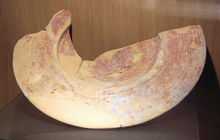Slip (ceramics)



A slip is a suspension in water of clay and/or other materials used in the production of ceramic ware.[1] Deflocculant, such as sodium silicate, can be added to the slip to disperse the raw material particles. This allows a higher solids content to be used, or allows a fluid slip to be produced with the a minimum of water so that drying shrinkage is minimised, which is important during slipcasting.[2] Usually the mixing of slip is undertaken in a blunger[3] although it can be done using other types of mixers or even by hand.
An engobe is a material similar to a slip, with somewhat lower clay content, higher proportion of flux, and added filler, and in some cases a colorant.[4]
Use
A slip may be made for various purposes in the production and decoration of ceramics. Slip can be used:
- As a means of mixing the constituents of a clay body.
- To shape ware by slip casting.
- To join of sections of unfired ware or greenware, such as handles and spouts.
- To adhere figures or other motiffs to unfired ware to form a bas-relief. This technique is known as sprigging, an example is Jasperware.[5]
- Decoratively when placed onto a wet or leather-hard clay body surface by dipping, painting or splashing. Such type of ware is often described as slipware. Slipware may be carved or burnished to change the surface appearance of the ware. Specialized slip recipes may be applied to biscuit ware and then refired. Decorative slips may be a different color than the underlying clay body or offer other decorative qualities. Colored slips can be used to create pieces of ceramic art by techniques similar to paint in other media.
- When slip is used to join two pieces of greenware together, it is generally used with a technique known as scratch and slip, whereby the contact points on both pieces are scored with multiple criss-crossing lines and slip painted on one piece over the scores.
References
- ↑ Dictionary Of Ceramics. Arthur Dodd & David Murfin. 3rd edition. The Institute Of Minerals. 1994.
- ↑ Industrial Ceramics. F.Singer, S.S.Singer. Chapman & Hall. 1971.
- ↑ Ceramic Whitewares - History, Technology And Applications. Rexford Newcomb, Jr. Pitman Publishing, 1947.
- ↑ http://www.duncanshearer.co.nz/glaze/engobes.html
- ↑ Dictionary Of Ceramics. Arthur Dodd & David Murfin. 3rd edition. The Institute Of Minerals. 1994.